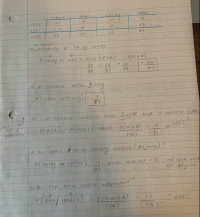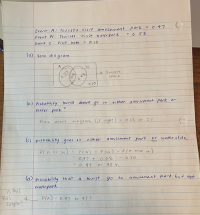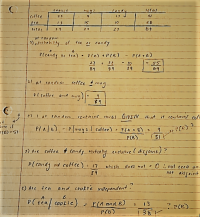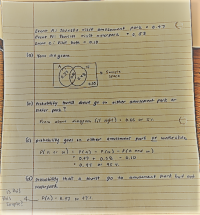Hi there,
I'm having some troubles understanding and applying the material for my stats class and was wondering if I could get some help.
My first question is regarding basic probability when looking at table. a) and b) were easy but for c) using the conditional probability has me confused. The question states "Choose 1 gift basket at random, find the probability that it contains mugs given that it contains coffee. Give your answer as a fraction" I think my logic is correct but I don't understand what P(B) is? 51? and also does the order of P(A l B) and P(B l A) matter? Did I do that correctly?
With d) I think I answered this one correctly based on my understanding of disjointed events, P(A and B ) = 0 and in this case it is not.
For e) I have the same problem with c) I think I did the top correct but am confused for the bottom.
My second question is for the page where I have written it out in pen -- I just don't know if I'm going in the right direction. Is it just that simple? was my Venn diagram making sense?
I appreciate anyone who takes the time to read this, I feel like a bit of an idiot -- thank you in advance
I'm having some troubles understanding and applying the material for my stats class and was wondering if I could get some help.
My first question is regarding basic probability when looking at table. a) and b) were easy but for c) using the conditional probability has me confused. The question states "Choose 1 gift basket at random, find the probability that it contains mugs given that it contains coffee. Give your answer as a fraction" I think my logic is correct but I don't understand what P(B) is? 51? and also does the order of P(A l B) and P(B l A) matter? Did I do that correctly?
With d) I think I answered this one correctly based on my understanding of disjointed events, P(A and B ) = 0 and in this case it is not.
For e) I have the same problem with c) I think I did the top correct but am confused for the bottom.
My second question is for the page where I have written it out in pen -- I just don't know if I'm going in the right direction. Is it just that simple? was my Venn diagram making sense?
I appreciate anyone who takes the time to read this, I feel like a bit of an idiot -- thank you in advance




